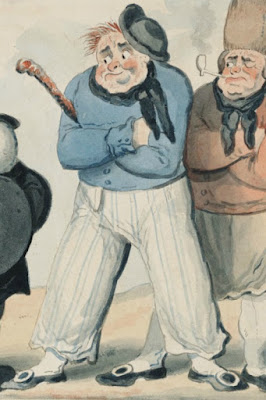 |
| “A distressed sailor”. After Rowlandson (1788), 1801. Lewis Walpole Library. |
Although the original print was created in 1788, before the time period this blog covers, its reissue in 1801 reflects the British public’s continued concern for aged or disabled sailors. The original print from the Royal Collection Trust is not colored, so this version gives us a good opportunity to see how an early 19th century colorist treated a 13-year-old image.
The sailor wears light brown breeches tied around the stump of one leg. The other leg is tucked up above the knee of the other, showing his bare leg and a blue and white vertically-striped stocking fallen down around his ankle. The seat of his breeches is painted a partly-missing, with no drawers worn beneath. His one black shoe has a round toe and is closed with black ties.
The sailor’s blue jacket has gaping holes in the shoulder and elbow that show bare skin underneath, but a white shirt-cuff is visible under the jacket’s open cuff, with both brass buttons unbuttoned. A spotted red handkerchief is tied about his neck, and he wears a black round hat. His brown hair is short and curly.






























